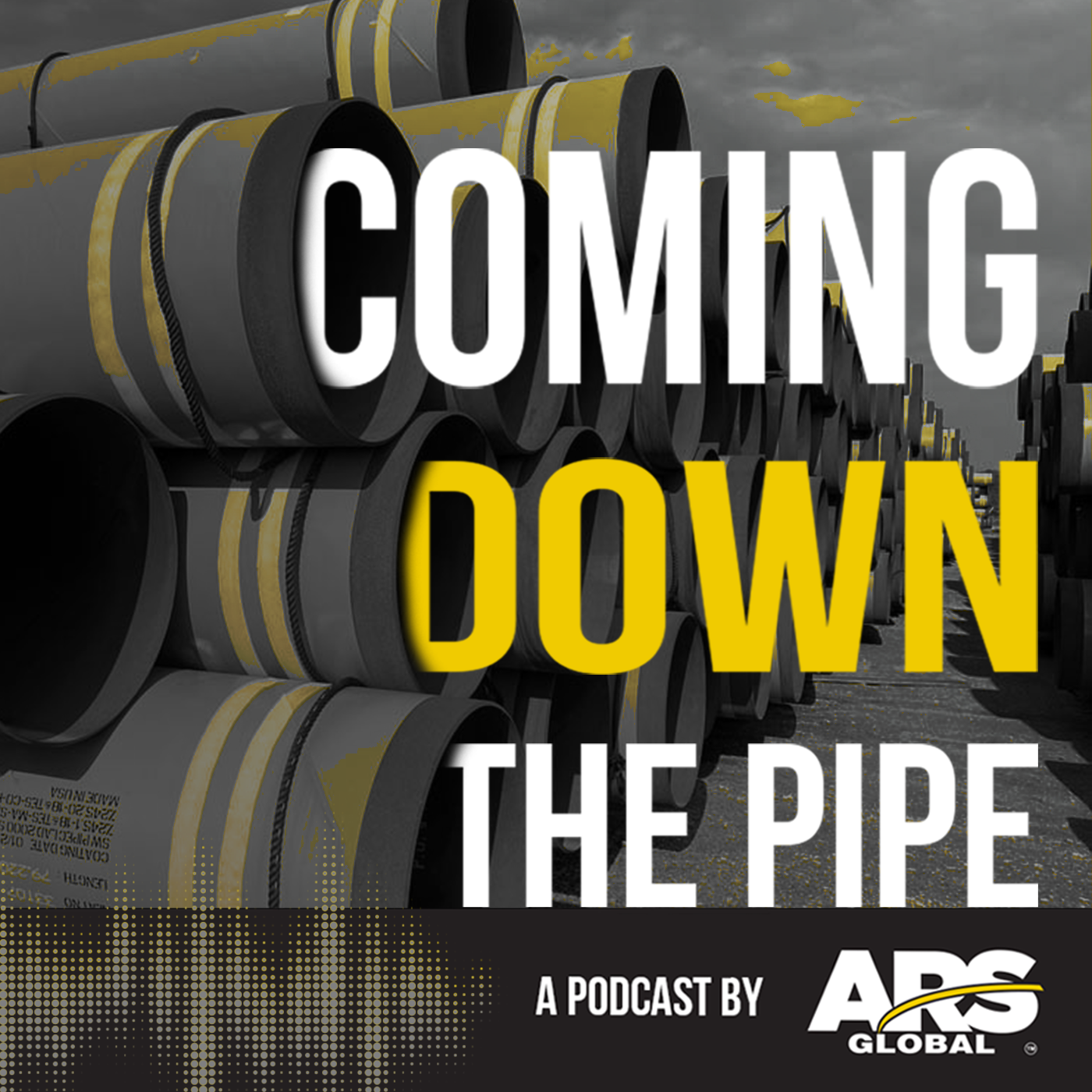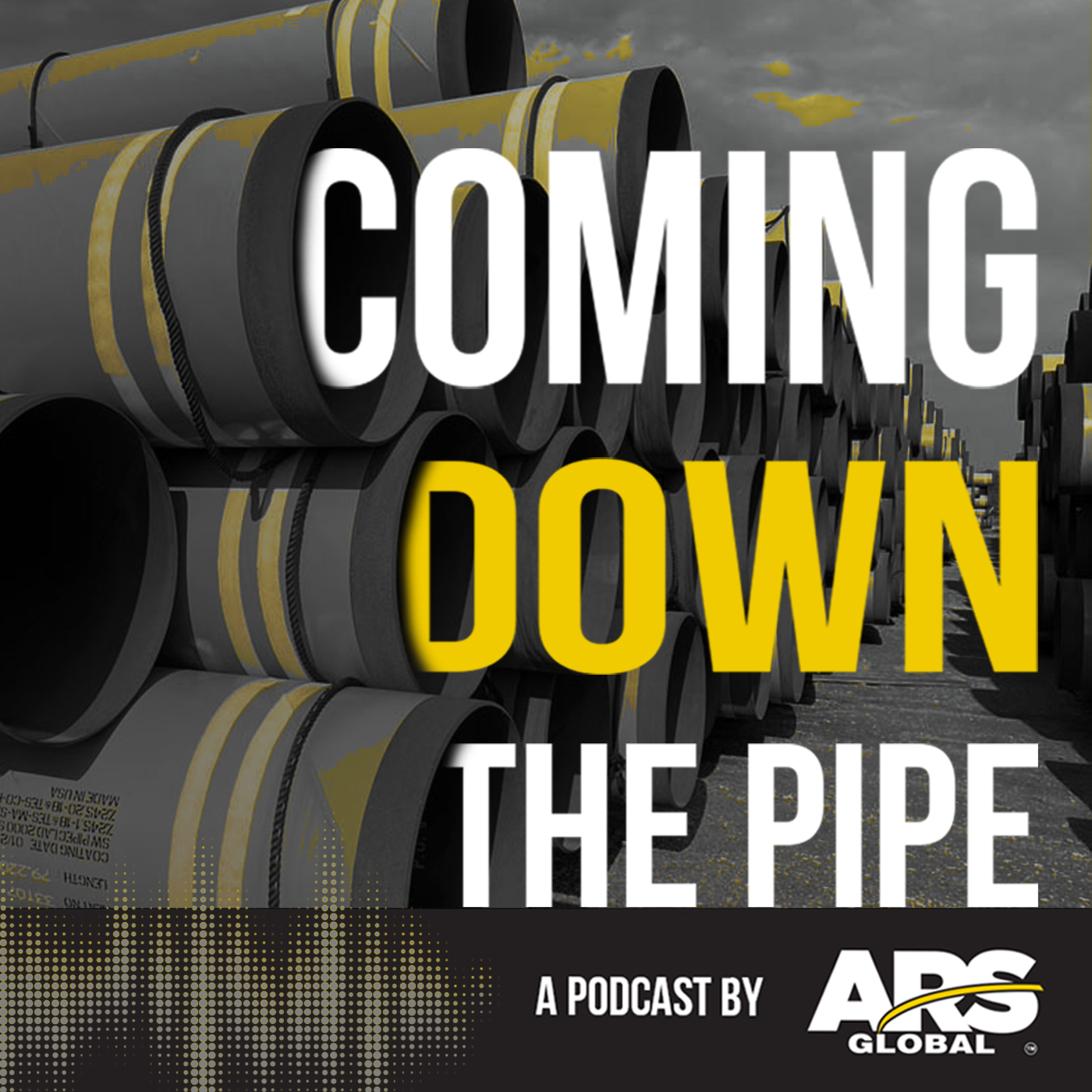Episode Transcript
Josh Averitt
Welcome to Coming Down the Pipe ARS Global's monthly podcast, where we talk about the pipeline industry assets, investments, pipeline construction and the market in general. ARS Global is the midstream partner for streamline sourcing solutions. I'm Josh Averitt, president of ARS Global. And today we have
Adam Jacobs
Adam Jacobs with OMC International. I'm a project manager for OMC. I've managed all their outgoing and incoming projects.
Josh Averitt
Welcome on, our podcast is still in its infancy, so we're still getting going. Appreciate you joining us today. Tell us a little bit about how you got into inspection?
Adam Jacobs
I started out in a coating facility in 2000, around 2010, and then went from there. A gentleman gave me a specification one day. It was actually the outgoing NACE spec. And then from there on it was basically there. I don't know.
Josh Averitt
Yeah. So, you, you live life on the road then.
Adam Jacobs
Yes, sir. Yeah.
Josh Averitt
Gone a lot.
Adam Jacobs
Yes, sir.
Josh Averitt
Great man. Well, thanks for having us on today, we're going to talk about basically asset inspection and integrity management for surplus assets. Specifically. ARS and OMC have worked quite a bit together on some fairly big projects and we just want to talk about and give our customers some insight on what we do.
On the surplus side. It's a little bit different than the new manufacturing side. So why don't we talk first a little bit about why Third-party inspection is required or desired by potential purchasers of surplus pipes, specifically on the on the API side.
Adam Jacobs
So usually when you're buying stock materials you run into it's been sitting for years, it's been sitting in stacks. The main concern is the way that it's been handled and stored. And when they buy a pipe, they want to make sure it's within API standards.
Josh Averitt
When we talk about API standards, we're talking about traceability, dimensional inspection, and then we move over to the coating. So, on the traceability side, fill us in on what steps OMC takes and specifically Adam takes on verifying the traceability on these assets because we all we've talked about in previous episodes on the surplus side where if it's not traceable, that is a complete nonstarter.
So the first things first, before we even talk about stripping, recoating, ovality measurements, anything like that, if it doesn't have a stencil and the associated paperwork, we're dead in the water. So, fill us in on the traceability verification process.
Adam Jacobs
So usually if we go out to a yard to do full traceability on pipe, we check heat number, pipe number footage, make sure every stencil is legible 100%. And at that point we will go down and we'll track every joint that's in there. Any joint that is not acceptable will be marked up and be set aside as a reject on our point.
Josh Averitt
And you guys provide some sort of report to certify that?
Adam Jacobs
Yes sir, you'll have full reports of everything that we do for traceability.
Josh Averitt
Okay, great and then once we have verified the traceability, the next question that our customers have is what's the steel quality? Right? You know, you talked about pipes sitting in yards and stacked and this and that. And one question that sometimes comes up is the physical dimensional specifications. Does it fall within API? So, tell us a little bit about how you guys manage that inspection process, taking measurements, reporting and what have you through the process of loading the pipe or down stacking the pipe.
Adam Jacobs
Yes. So, if it's something that is acquired for API standards for the customer, then we go in and make sure that everything's destacked, we do 100% ovality checks on both ends of each joint, we check squareness. We check bell angles. Anything that is required within API. Like I said, if it's been sitting for a long time, you'll run into the issue where a pipe has been sitting in the mud for pitting or anything like that in which the pipe could be cut off and repaired at that point. But if the customer doesn’t want it, then it won't be sold to them.
Josh Averitt
Got it. Great. And then once we verify that the physically the pipe meets API specifications, the pipe is fully traceable and that's been verified and reported. Tell us about how you measure the coating degradation, because we all know that as it sits out in the sun, the UV rays or whatever you want to call it, degrade the coating. How do you take coating readings and determine, hey, this pipe is good to go straight from the stack to the right of way, or this pipe needs to be stripped and recoated.
Adam Jacobs
Well, in basic knowledge of the coating industry. Your mills are usually 14 to 16 mills minimum. And at that point we usually go in and we do up to ten readings per joint. And if we have any low readings and we will mark the area, then we'll check in a five-point reading all the way around the area. Then we do an average on it. If that average is not above what is allowed for the order, it's considered as a reject at that point.
Josh Averitt
Okay, great. And let's say that, you know, you're starting to get consistent low readings and the customer determines, hey, this stack, we're not going to do a bunch of two-part repairs. We're not going to mess with trying to get this up to spec. We just want to strip it and recoat it. At that point. You know, there's several recoaters in the United States that you guys probably work with. With all of them.
Adam Jacobs
Yes, sir.
Josh Averitt
That pipe gets shipped to the coater and gets stripped down to bare pipe and then recoated for the customer’s spec. Walk me through the process of stripping that pipe, inspecting it while it's getting stripped, inspecting it while it's getting coated. What are all of the check points and the stage gates throughout that process that you guys’ report on so that our customers know, hey, even though the old coating was bad, this pipe is essentially brand new. It's traceable, it's verified, it's recoated to a new spec.
Adam Jacobs
So, once it goes to a coating facility, we do full traceability at that point. Again, make sure everything's 100%. At that point the stencils are removed, they're in a strip in process. We have them re add the stencil back on it during a certain point, then retrace each joint. Once again, we check for Chlorides just in case there's Chlorides inside there blasting grit.
Josh Averitt
What would Chlorides do to their pipes?
Adam Jacobs
It would cause failure of bonding of coating. So, which most mills now in America they do acid wash before they coat pipe and it basically cleans all contaminants from it. But still, you have to make sure everything's 100% before it goes through the coating. Once it's into the coating facility, then the pipe is recoated again to make sure that every stencil is 100% on both ends. Then the pipes blasted. It goes to a station where everything's checked. Chlorides check for pitting for any kind of deep grinds, anything that's going to affect the pipe and that's API and NACE we're going based off of most jobs are based off API and NACE.
Josh Averitt
Got it.
Adam Jacobs
Then at that point the pipe is sent down the line and recoated, acid washed and then recoated.
Then once it's to the final branch, then they will do mill checks, make sure that there's no bevel damages, make sure that everything's within tolerance allowed for the work order. Specifications are very important to the customer. So, we want to make sure that the customer is getting the prime pipe that they purchase at that point. Then they take lab samples. Then the lab samples will be everything we tested to NACE at that point, if everything is 100%, then the pipe will be primed.
Josh Averitt
Great. Now that that sounds good and you know, I think one of the things to point out, especially for API surplus pipe is one of the reasons that third party inspection is always we say desired, required. We don't do anything without third party inspection and that's basically to keep everybody honest in the process, make sure that our customers are getting what they ordered. And it's in the condition that we say it's going to be in when it arrives to the right of way and or the lay down the yard. So, when it does arrive to a lay down yard after it's been through all the processes that you've talked about and you guys have verified through all the stage gates and checkpoints and all of that, is there is there some inspection that needs to go on at the laydown yard during the offloading process?
Adam Jacobs
You'll have some minor damages and defects on the coating that can be fixed at that point. A lot of times it comes from the loading process out of the mill itself, and that's why a third party is very important at that point too as well.
Josh Averitt
Great.
Adam Jacobs
You want to make sure everything's 100% the customer wanting to buy prime pipe and that's what third party is there for.
Josh Averitt
That's right. That's right. Well, great, man. Hey, look, we really appreciate you joining us today. Very informative on the surplus side. A lot of our customers, they're very used to the pipe ordering process where traditionally it just goes out to bid from a mill and they say, hey, I want X sized pipe delivered at Y location and its very hands off. We have to put a little bit more elbow grease into it on our side and then manage some more processes, specifically on the coating. And thanks to third party inspection like yourself and y’all’s company, our customers have the security and the peace of mind knowing that they're going to get fully traceable, verified prime pipe like you were talking about, deliver to the location that they want on time. So yeah, I appreciate you joining us. Be sure to subscribe to the podcasts on any major platform that you get podcasts on. You can rate our podcast and we'll see you next month on Coming Down the Pipe ARS’s monthly podcast. So, thanks, Adam.
Adam Jacobs
Thanks Josh, I appreciate it.


